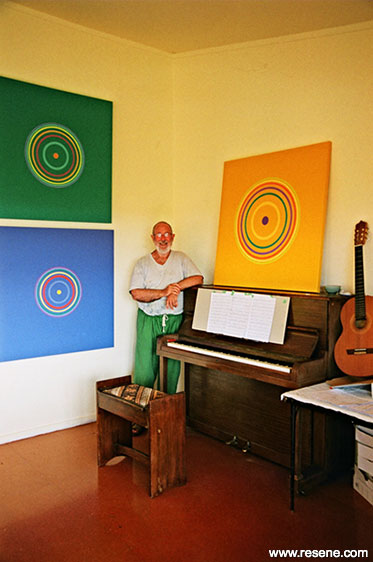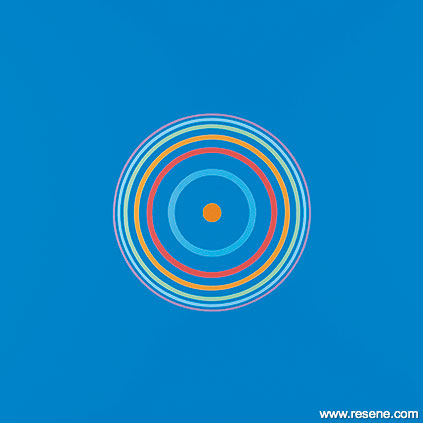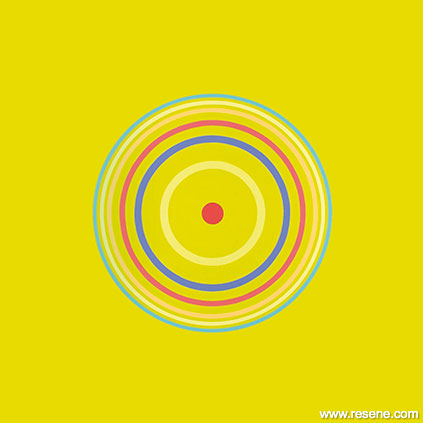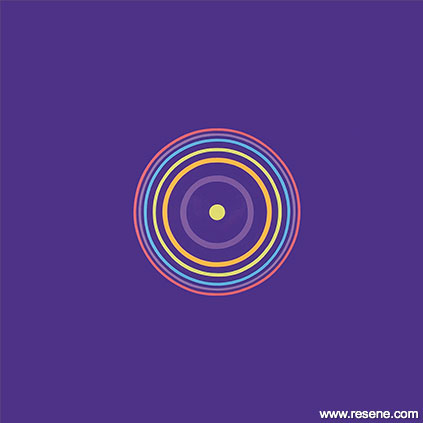From Habitat magazine - issue 09
Well-known artist Michael Smither has literally captured the colour of sound in a recent exhibition.

Artist Michael Smither has always been fascinated by the relationship between music and art.
In radiant Resene colours, big, bold, bullseyes pulse out from the canvas like sound waves. The longer you look, the meticulously painted concentric circles turn and vibrate with a compelling energy. Michael Smither’s startling latest artworks – The Colour of 12 Sounds – which exhibited at Artis Gallery in Parnell, Auckland, this year may seem a radical departure from what most of us know of the artist.
One of our leading realist painters, Smither is perhaps best known for his quirky representational approach to coastal and mountain landscapes, people and domestic objects. But during his long and prolific career, he has constantly returned to the theme of relationships between colour and sound.
That’s not something unusual for artists, says Smither. “Throughout history, there have been artists and musicians who have made these kind of connections. But they’ve done it from an emotional response. I’m not doing that. I’m saying there’s logic to both the colour spectrum and the octave, and they’re related. Therefore, the whole thing can become very specific.”
It seemed obvious for Smither to pursue a way to notate colour and hue that could be specifically interpreted in a musical composition. In these paintings, he finally seems to have cracked the code.
His journey began back at Elam School of Art in the 1960s. Smither designed the set for Stravinsky’s ballet, Rite of Spring, with abstract shapes and colours that related to the music’s dynamics and rhythms.
During the years, several more attempts were made to match compositions with shapes and colour. His most successful experiment though was with children. As part of a tour to promote his exhibition The Wonder Years, the opportunity arose to conduct three workshops.
These involved the interaction of four musicians and some children aged between four and 11. The children were given small squares of coloured paper and asked to make a pattern, gluing them onto sheets of card. Smither then marked the square of colour on each card with the equivalent musical note. The musician scanned and played these patterns of notes as they saw them and then as directed by the children. Having tried out the patterns on the musicians, many children chose to add to or alter their pattern to hear the difference. “The resultant sounds and random combinations of patterns as lines of children filed one by one up to each musician was spellbinding,” says Smither.
Three works from Michael’s recent exhibition The Colour of 12 Sounds



The Colours of 12 Sounds pushed Smither’s investigations further by describing the colour of a note in the octave and showing each colour’s harmonics in a series of concentric circles.
Smither’s son also concealed small devices that you could push at the bottom corner of the paintings. These emitted a short piece of music, composed by Smither, which had structurally the same set of musical notes for each painting. The more vibrant the colour, the more energetic the sounds.
Smither says his idea was very simple. “It’s quasi-mathematical. You take the octave as a phenomenon that’s made by taking a string and dividing it in half. From one end of the octave to another, you get a doubling of the frequency.
“Western music is divided into 12 notes. So you take the spectrum of colour, which shares a doubling of frequency from one end to the other. You take that and lay it on top of the octave of sound. Most people use their intuition to understand how colours relate. But as I was making colour that musicians wanted to play, it had to be very logical and specific.”
Smither took the note A – the lowest frequency – and the colour red, which is the base of the lowest frequency of the colour spectrum. The rest is quite logical.
Reaction to the artworks has been very pleasing. “Six were even excited enough to buy the works,” he jokes. Abby Sisam from Artis says many children enjoyed the show. “It had a visual language. Even if you can’t understand the complexities of the music, you still respond at a visceral rather than a cerebral level.”
All the colours used in the paintings are Resene waterborne decorative paints, paints Smither has used all his life. The fact that they are based on British Standard colours means that if the works ever need to be restored, then you can find exactly the right colours.
Using Resene paint offered a new connection which inadvertently inspired Smither’s next exhibition. “In talking to Resene’s chemist, I think he was quite puzzled by my idea. But he did alert me to an idea about an actual hue of colour. That got me thinking, this time I only got it half right. So next time, I am not going to have coloured backgrounds. They will be black or white. It will be the width of the lines that represent the position of the octave. I’ve added white which makes the line diminish. I realise what I was doing was trying to knock opinion with a sledgehammer. All I needed to do was keep the width of the colours related to the vibration length and note, and that would be sufficient to express the idea.”
Michael Smither used...
Search habitat magazine stories
Printed copies of habitat highlights are available from late March 2024 at Resene ColorShops and resellers, while stocks last. You can view back issues of habitat magazine online.
Specifiers:
If you have an idea, project or story that you think would suit habitat, we’d love to hear from you. Please drop us an email with your details and include photos if submitting a project.
Sign up for a DIY card and Save! Australia | New Zealand